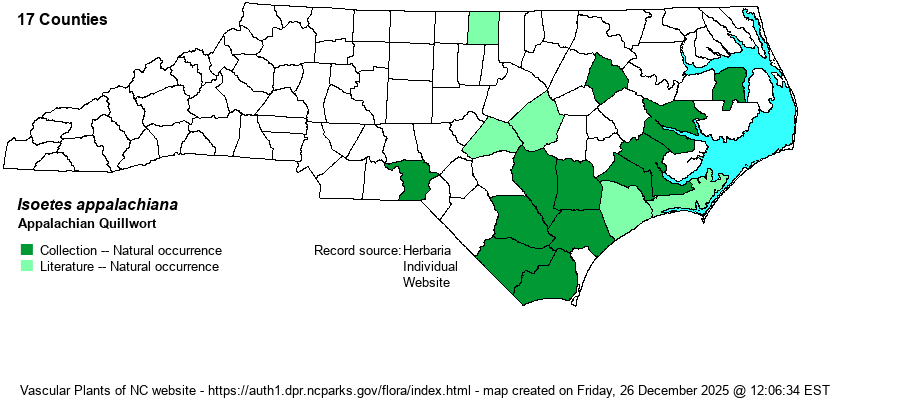| Section 1 » Order Isoetales » Family Isoetaceae |
Show/Hide Synonym
| taxonName | relationship | relatedTaxonName | relatedTaxonRefText | relComments |
|---|
|
|
|
|
|
| Isoetes appalachiana | < | Isoetes engelmannii | Gleason and Cronquist (1991) | | | Isoetes appalachiana | < | Isoetes engelmannii | Flora of North America (1993b, 1997, 2000, 2002a, 2002b, 2003a, 2004b, 2005, 2006a, 2006b, 2006c, 2007a, 2009, 2010) | | | Isoetes appalachiana | < | Isoetes engelmannii | | | | Isoetes appalachiana | < | Isoetes engelmannii | Radford, Ahles, and Bell (1968) | | | Isoetes appalachiana | < | Isoetes engelmannii | Wofford (1989) | | | Isoetes appalachiana | < | Isoetes engelmannii | Flora of West Virginia | | | Isoetes appalachiana | < | Isoetes engelmannii var. engelmannii | Fernald (1950) | | | Isoetes appalachiana | < | Isoetes engelmannii var. engelmannii | Small (1933, 1938) | | | Isoetes appalachiana | > | Isoetes engelmannii var. georgiana | | | | Source: Weakley's Flora |
|
| Author | D.F. Brunton & D.M. Britton | |
| Distribution | This is a fairly newly described species (Brunton & Britton 1997). It is scattered over most of the Coastal Plain, though scarce in the northern portion. A few records for the eastern Piedmont: Richmond County (ID verified) and perhaps Wake County (needs ID). Mountains records are probably all I. engelmannii sensu stricto. We have mapped only those specimens that were mapped by Brunton & Britton (1997) as I. appalachiana or that were annotated by C.F. Reed in 1961 as I. engelmannii var. georgiana. However, most species of this cryptic genus are under-collected, and thus the range should be more widespread than shown on our map. Records from NCNHP (light green) need vetting.
This is a sparsely collected species in the East, ranging from PA southward to northern FL. | |
| Abundance | Poorly known, but seemingly not scarce in the Coastal Plain. The NCNHP's State Rank of S3S4 suggests that it is not rare, and perhaps is at least locally fairly common in the southeastern half of the Coastal Plain. Likely very rare to rare elsewhere. Taxon editors suggest a rank of S3 for NC. | |
| Habitat | "Seepages, small woodland streams, ephemeral wetlands, backwaters" (Weakley 2018). | |
| Phenology | Fruiting period has perhaps not been described. | |
| Identification | All Isoetes species are quite grass-like, with numerous very slender and grass-like leaves growing from a common base. Most importantly, they are swollen at the base, where the megaspores are present, the key structure for separation of species. The leaves are terete (rounded) and hollow. For identification, see the key in Weakley (2018). | |
| Taxonomic Comments | The species was first described by Brunton & Britton in 1997 (see References). It was a part of I. engelmannii in most references before being pulled out as a distinct species. Brunton & Britton treat I. engelmannii var. georgiana as a synonym. It is a tetraploid, vs. diploid in I. engelmannii.
All Isoetes species are quite grass-like, with numerous very slender and grass-like leaves growing from a common base. Most importantly, they are swollen at the base, where the megaspores are present, the key structure for separation of species. The leaves are terete (rounded) and hollow. For identification, see the key in Weakley (2018). | |
| Other Common Name(s) | None | |
| State Rank | S3S4 | |
| Global Rank | G4 | |
| State Status | | |
| US Status | | |
| USACE-agcp | OBL link |
| USACE-emp | OBL link |

